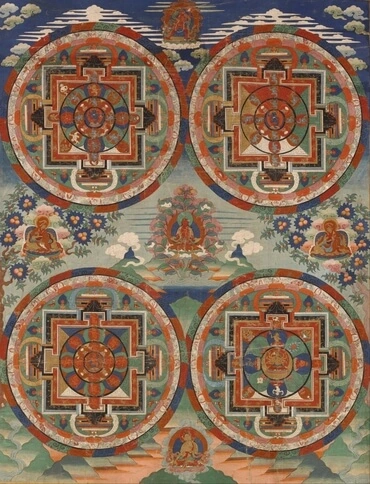1
Ja Tabernaklin pitää sinun tekemän kymmenestä vaatteesta: kalliista kerratuista liinalangoista, sinisistä, purpuraisista, ja tulipunaisista villoista. Gerubimin sinun pitää tekemän taitavasti sen päälle.
2
Kunkin vaatten pituus pitää oleman kahdeksan kyynärää kolmattakymmentä, ja leveys pitää oleman neljä kyynärää: ja niillä kaikilla vaatteilla pitää yksi mitta oleman.
3
Viisi vaatetta pitää yhdistettämän toinen toiseensa, ja taas viisi yhdistettämän toinen toiseensa.
4
Sinun pitää myös tekemän silmukset sinisistä villoista ensimäisen vaatteen reunaan, äärimäiset kulmat yhteen sidottaa: ja niin sinun pitää tekemän äärimäisen vaatteen reunaan, sen kulmat yhteenpantaa toistamiseen.
5
Sinun pitää tekemän viisikymmentä silmusta ensimäiseen vaatteesen, niin myös viisikymmentä silmusta äärelle vaatetta, joka toisessa yhdistyksessä on; ja silmukset pitää oleman toinen toisensa kohdalla.
6
Ja sinun pitää tekemän viisikymmentä kultaista koukkua, ja ne vaatteet yhdistämän toinen toiseensa niillä koukuilla, niin että se tulis yhdeksi Tabernakliksi.
7
Ja sinun pitää tekemän yksitoistakymmentä vaatetta vuohen karvoista, peitteeksi Tabernaklin päälle.
8
Jokaisen vaatteen pituuden pitää oleman kolmekymmentä kyynärää, ja leveyden neljä kyynärää, ja leveyden neljä kyynärää. Ja kaikki yksitoistakymmentä pitää oleman yhdensuuruiset.
9
Viisi vaatetta pitää sinun toinen toiseensa yhdistämän erinänsä, ja myös kuusi vaatetta erinänsä; niin ettäs teet sen kuudennen vaatteen kaksikertaiseksi etiseltä puolen Tabernaklia.
10
Ja sinun pitää tekemän viisikymmentä silmusta ensimäisen vaatteen reunaan, äärelle, josta se yhdistetään ja myös viisikymmentä silmusta siihen vaatteen reunaan, josta se toinen kerta yhdistetään.
11
Niin myös pitää sinun tekemän viisikymmentä vaskikoukkua, ja paneman koukut silmuksiin ja yhdistämän majan, että se olis yksi maja.
12
Vaan se liika joka ylitse jää Tabernaklin vaatteesta: nimittäin puolen siitä liiaksi jääneestä vaatteesta, pitää sinun antaman riippua ylitse Tabernaklin, perän puolella.
13
Ja yksi kyynärä pitää oleman yhdellä ja yksi kyynärä toisella puolen, sen ylitse jääneen majan vaatteen pituudesta: sen pitää riippuman Tabernaklin sivuilla siellä ja täällä, sitä peittämässä.
14
Mutta tämän ensimäisen peitteen päälle sinun pitää tekemän toisen peitteen punaisista oinaan nahoista, ja vielä sitten ylimmäisen peitteen tekasjim-nahoista.
15
Sinun pitää myös tekemän Tabernaklin laudat sittimipuusta, pystyällä olemaan.
16
Jokaisen laudan pituus pitää oleman kymmenen kyynärää, vaan leveys puolitoista kyynärää.
17
Kaksi vaarnaa pitää jokaisessa laudassa oleman, niin että he taittaisiin yhdistettää toinen toiseensa. Näin pitää sinun tekemän kaikki Tabernaklin laudat.
18
Ja sinun pitää tekemän Tabernaklin laudat, niin että kaksikymmentä lautaa pitää oleman etelän puolella.
19
Ja neljäkymmentä hopiajalkaa pitää sinun tekemän kahdenkymmenen laudan alle, niin että jokaisen laudan alla pitää oleman kaksi jalkaa, kahden vaarnansa päällä.
20
Niin myös majan toisella sivulla pohjan puolella pitää oleman kaksikymmentä lautaa.
21
Ja neljäkymmentä hopiajalkaa: aina kaksi jalkaa kunkin laudan alla.
22
Mutta perällä Tabernaklia länteen päin pitää sinun tekemän kuusi lautaa.
23
Ja kaksi lautaa pitää sinun tekemän Tabernaklin perälle, niihin kahteen kulmaan.
24
Niin että kumpikin niistä taittaisiin yhdistettää silmuksella sekä alhaalta että ylhäältä: yhdellä tavalla pitää he molemmista kulmista yhdistettämän kulmakiskoilla,
25
Niin että yhteen olis kahdeksan lautaa, ja heidän hopiajalkansa kuusitoistakymmentä: aina kaksi jalkaa kunkin laudan alla.
26
Sinun pitää myös tekemän korennot sittimipuusta: viisi niihin lautoihin, jotka yhdellä Tabernaklin sivulla ovat;
27
Ja viisi korentoa niihin lautoihin, kuin toisella Tabernaklin sivulla ovat: ja viisi korentoa myös niihin lautoihin, jotka perällä Tabernaklia ovat, länteen päin.
28
Ja keskimäinen korento pitää keskeltä lautoja käymän yhdestä kulmasta niin toiseen.
29
Ja sinun pitää laudat kullalla silaaman, ja kullasta renkaat niihin tekemän, joihinka korennot pistetään, ja sinun pitää myös korennot kullalla silaaman.
30
Ja niin pitää sinun Tabernaklin pystyälle paneman, sen muodon jälkeen, kuin sinä näit vuorella.
31
Esiripun pitää myös sinun tekemän sinisistä, purpuraisista ja tulipunaisista villoista, niin myös kalliista kerratuista liinalangoista, ja tekemään Kerubimit sen päälle taitavasti.
32
Ja sinun pitää ripustaman sen neljän sittimipuisen, kullalla silatun patsaan päälle, ja niiden kultaiset koukut, neljän hopiajalan päälle.
33
Ja sinun pitää ripustaman esiripun koukuille, ja paneman todistusarkin sisälliselle puolen esirippua, niin että esirippu olis teille erotus pyhän ja kaikkein pyhimmän vaiheella.
34
Armo-istuimen pitää sinun myös paneman todistusarkin päälle, kaikkein pyhimpään.
35
Ja paneman pöydän ulkoiselle puolen esirippua, ja kynttiläjalan pöydän kohdalle, päivän puolelle Tabernaklia, niin että pöytä seisoo pohjaan päin.
36
Ja sinun pitää tekemän peittovaatteen Tabernaklin oveen, sinisistä, purpuraisista ja tulipunaisista villoista, niin myös kalliista kerratusta liinalangasta, taitavasti ommellun.
37
Tätä peittovaatetta varten pitää sinun tekemän viisi patsasta sittimipuusta ja ne kullalla silaaman, ja koukut pitää oleman kullasta: ja sinun pitää valaman niille viisi vaskista jalkaa.







